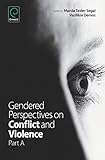Gendered perspectives on conflict and violence: part A / edited by Marcia Texler Segal, Vasilikie Demos
Texler Segal, Marcia [editor] | Demos, Vasilikie [editor/a].
Tipo de material: Libro
impreso(a)
Series Editor: Bingley, Bradford: Emerald Group Publishing Limited, 2013Descripción: ix, 301 páginas ; 24 centímetros.ISBN: 1783501103; 9781783501106.Tema(s): Violencia doméstica o por razón de sexo
Libro
impreso(a)
Series Editor: Bingley, Bradford: Emerald Group Publishing Limited, 2013Descripción: ix, 301 páginas ; 24 centímetros.ISBN: 1783501103; 9781783501106.Tema(s): Violencia doméstica o por razón de sexo| Tipo de ítem | Biblioteca actual | Colección | Signatura | Estado | Fecha de vencimiento | Código de barras |
|---|---|---|---|---|---|---|
| Libros |
Biblioteca San Cristóbal
Texto en la configuración de la biblioteca San Cristóbal |
Acervo General | 362.8292 G4/A | Disponible | ECO010017645 |
Incluye bibliografía
List of Contributors.. Information for Authors.. Gendered Perspectives on Conflict and Violence: An Introduction.. Gender and Violence: A Consideration of Victims and Perpetrators.. Victimized Again? Intersectionality and Injustice in Disabled Women's Lives After Hate Crime and Rape.. Feminist Reflections on Disability Hate Crime.. Intimate Partner Violence Among Self-Identified Queer Victims: Towards an Intersectional Awareness in Scholarship and Organizing Surrounding Gender-Based Violence.. In Letting the Perpetrator Speak: Sexual Violence and Classroom Politics.. Gender and Violence as Contextualized Nationally/Globally.. Invisible Lives, Silenced Violence: Transphobic Gender Violence in Global Perspective.. Belonging to the Jewish Nation: Life Stories of Israeli Female Combat Soldiers.. Private War, Private Suffering, and the Normalizing Power of Law.. Significance of Wartime Rape.. Out of Southeast Europe: Gender-Based Violence, Public Transitions, and the Search for Home.. Layers of Violence: A Gender Perspective on Media Reporting on Infant Rape in South Africa.. Gender Equality, Attitudes to Gender Equality, and Conflict.. About the Authors
The chapters in this two-part volume deal with a range of gender-based violence issues that are making news headlines daily. In Part A the contributors address the ways in which wartime rape is treated in international courts, why and how the gender language used at the United Nations matters, how asylum-seekers fleeing gendered violence are treated, how the press and the courts frame rape and other acts of violence, perceptions and responses of and to disabled and LGBTQ people who are victims of gendered violence, the ways we respond to the perpetrators of violence, and the relationship of military service to nationalism. The focus of the volume is global in the sense that international law and tribunals are discussed and norms and attitudes from global samples are compared. A variety of qualitative and quantitative methods including interviews, textual analysis, autoethnography, and secondary analysis of large sample surveys are employed. Each of the chapters has theoretical as well as policy or social implications. eng
